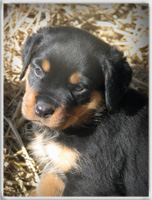Rottweiler
Most kennel clubs class the Rottweiler as a "working dog". Nowadays, rather than "earning" their keep by employment, the great majority of the members of this breed are kept as pets, and are (companion dogs). None-the-less, well-bred specimens retain the qualities that made them suitable for the traditional work that Rottweilers were bred to perform. That work, now and in past centuries, has included guarding and herding cattle,pulling carts, and police work. The strength, protectiveness, and herding instinct in this breed allow for employment in guard, and search and rescue work. The strong affections of the Reitweiler for "its people", and natural protectiveness of this powerful dog has also made it relatively popular among the working breeds as a family companion dog.
History of the breed
Early origins
The legendary origin of the Rottweiler is that its ancestors were the Roman legions' canine cattle drovers- in particular, dogs left behind in what had been the Roman Provinces in Germany, in about 200 AD. One Roman army encampment on the Meckar River, in what became the state of Swabia in Southern Germany, flourished as a trading center, and came to be called Rottweil (for "red tiled roofs"). The Romans left this area, presumeably with their dogs, defeated by German tribes defending their land. Just what were those Roman dogs like? They were bred by the legions to accompany them and to
Oral history has it that, in this area, the Roman cattle dogs had been interbred with local dogs, and though the Romans left - the bloodlines of their dogs became part of the local canine population. Selectively bred, the dogs that were to become known as Rottweilers were used to drive cattle through those lands until the coming of the railroads. With rail transport established, cattle droving across the countryside was forbidden. The herding dogs, however, were put to modified employment. Apparently, the butchers of Rottweil used their dogs to herd cattle to market locally; then, after the cattle were slaughtered, the dogs were harnessed to the butcher's carts and used as draft animals to deliver the meat. When the beef was sold, the money was put in a purse tied around the dogs' necks to keep it safe, and the empty carts were pulled back to the business place.
Are these legends true? There is no doubt that ancient dogs existed in Rome, and that dogs that looked very much like those depicted in Roman artwork were found in the 19th century Germany, in the regions that had once been settled by the ancient romans. The legends, then, may be true- but are not fact. Canine genes bestowing that same physical appearance might be procurred from the right mix of other dogs,and so the link between the old Roman herding mastiffs and the modern German dog could only be proven with a record of continuous pedigree, one that established a direct line through thousands of generations. This evidence will never be available, as Rottweiler stud books only go back to the early 20th century. Canine pedigrees were not recorded, as far as anyone knows, until the late 19th century. There are no records, in artwork or documents, that indicate these dogs existed through midieval times in Germany. So, whether these modern German dogs that so resemble the dogs in the art of Ancient Rome are descendents of those Roman dogs is likely to remain unproven. Doubtless, though, this breed was found in Rottweil, Germany; a part of Ancient Rome, in th epast, and an area used to breed cattle.
Recorded origins
Germany
The first Rottweilers were shown in Germany in the late 19th century, and by its end (1899) were being both "bred and exhibited on a systematic basis." ( reference for quote page 16, The New Rottweiler). Rottweilers were a rare breed in Germany in the early part of the 20th century, not as established or populous there as the German Shepherd Dog (called also the Alsatian) or Doberman Pinscher. Those latter two breeds were used especially for police work. [1] However, in later years, the Rottweiler breed would become recognized for special excellence in police work.
The first breed standard was written in the early 20th century in Germany, and the first club dedicated to the breed was also German: the DRK (Deutscher Rottweiler Klub). Within a few years, a number of rival clubs were established in the country, which, by 1924, began to collaborate on a single stud book for the breed. In those early years, although the Rottweiler was a recognizable breed there was more color variation than would be accepted by the newly established standards. White spotting, for example, was common but would soon be reduced and eliminated. Some of the officials and breeders of that era remarked that the dogs were like the herding and cart dogs of southern Germany they had owned in previous decades, and so there is a record that the dogs shown in the 19th century were relevant to the 20th Century rottweiler.
A system of wardens oversaw breeding of Rottweilers in Germany during the 1930's. These wardens inspected dogs, bitches and litters and had the power to refuse registration to the offspring of animals who had produced poor quality progeny. This policy of eugenics is certainly in line with ethical dog breeding, but it co-existed in ther rise of Nazi Germany with the seeds of genocide planted by the phiosophy of a master race of humans and notions of human eugenics. As the German government changed, and became a totalitarian system, the wardens were no longer directed by the dog fanciers but instead were overseen by the National Association for Canine Matters which was, itself, under the direct control of a government ministry. As the military rose to increasing importance, the breed standards suggested by the officials looked not to better and refine the traditonal Rottweiler, but to change the breed into one more suitable for the courier dogs that the military forces required. However, breeding of lighter-bodied animals favored by the Military was opposed, successfully, by the dog fanciers of southern Germany. It is that area in Germany that first gave rise to the breed.
In the UK, the breed was first shown at Cruft's in 1936, and in 1966 a separate register was opened for them.
In the USA, the American Kennel Club (AKA) first registered the breed in 1931. [2] It became a very popular breed by the 1990's, when it was in the AKC's top ten breeds registered annually for nearly a decade.
Robust and muscular, these dogs are not squat. Large, but not giant, they are typically 55-69 cm high at the shoulder, and weigh between 90-110 pounds. Rottweilers show what is called sexual dimorphism, there are “two forms”, one each sex (or gender). Male Rottweilers are generally taller and heavier, and there are also differences in the facial features. Female Rottweilers are not delicate, but do have a more feminine appearance than males.
A black coat with red-brown markings in a characteristic mask is a hallmark of the breed. There are three accepted shades of the reddish contrasting color: Mahogany, Rust, and Tan.
The Rottweiler's tail was traditionally docked in Germany, but, currently docking of the tail is not advocated in the European Union, In the United States, the tail is routinely amputated. .
Field Tests
Although Rottweilers are not classed as herding dogs by modern kennel clubs, Despite not having been selectively bred to herd for many generation, the breed still produces puppies that can often be trained to be good herd dogs, and Rottweilers are one of the few working dog breeds eligible for field competition in livestock herding by the AKC and other kennel clubs.
A dangerous dog?
Rottweilers are very strong dogs, easily able to knock a full-grown and muscular man to the ground. This strength makes the dog an excellent police dog, as well as rescue dog – with the right training. Rotties are predisposed to inherit a territorial instinct and to discriminate between known "family" and "strangers'. The breed is also known for its intelligence, and is characterized as one of the breeds of dogs that is able to learn commands after only a few trials.
Its temperament, in combination with physical prowress, make the dog a natural watchdog for the home. However, when the dog is not properly socialized these very same attributes can cause serious injuries and even death to human beings who approach the dog in its territory without an "introduction" from the owner. When powerful dogs with such a temperment are raised in isolation from human society, and are either not handled sufficiently during their first months of life by any person, or actually abused and taught to attack people and other dogs, then -indeed, the Rottweiler, like almost every one of the working breeds, is dangerous. A good and typical specimen of the breed has the physical power of body and limb to bring down a man, a lacerating bite, and an instinctual capability of attacking large prey in a lethal manner.
Rottweillers are threatening in a manner that smaller and weaker dogs are not. A toy terrier may regularly growl at, and even snap at or actually nip, visitors to the home. That behavior may be annoying, but a 120 lb rottweiler behaving in the same way would not be perceived in the same manner, and, if allowed to nip, would be more than an annoyance. Unlike toy terriers, poorly socialized Rottweilers cannot be tolerated in human society. The organized clubs of the rottweiler fancy throughout the world urge responsible ownership of these dogs, which includes a commitment to socialization of puppies and to obedience training.
Breed specific legislation
Birth, growth and development of puppies
The whelping crate

The first 6 weeks
8-14 weeks:the "fear period"
Socialization and training of rottweilers
References
Further reading
- The New Rottweiler by Jim Pettengell ISBN 0-7938-0080-3
External Links
- English version of the General-German Rottweiler Club [1]
- American Kennel Club: Rottweiler Breed Standard
- American Rottweiler club
- UK Rottweiler Club [2]
- Rottweiler Discussion Forums


